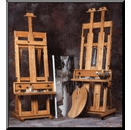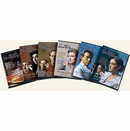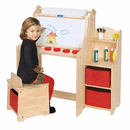How to Pick the Perfect Paintbrush
How to Pick the Perfect Paintbrush
So often, painters agonize over the quality and price of their paints. They know that a good, quality paint can make the difference between an average painting and the next masterpiece. However, expert and novice painters alike often forget the key role that paintbrushes play in creating beautiful art. Paint brushes are the vessel that carries the paint to—and applies—the paint to your canvas. Therefore, knowing how to pick the perfect paintbrush for your budget is vital to successful painting.
Construction
Paint brushes are made of three parts: the handle, the ferrule, and the tuft. Each of these parts contributes to the overall feel and quality of a paintbrush.
Make sure that hardwood handles are lacquered or enameled, to prevent deterioration. Choose a handle that feels comfortable in your hand and provides an easy grip.
Generally, the higher-quality paintbrushes have nickel-plated ferrules that are attached to the handle without double-crimping. Look for ferrules that are seamless, as they help prevent solvents from leaking inside and damaging the tuft.
What Makes a Good Paint Brush?
You now know what parts actually make a paintbrush. But what makes a good paintbrush? While handle and ferrule construction play a vital role in the quality and feel of a paintbrush, it is the tuft that draws the most attention—and rightfully so. As the part of the brush that actually applies paint—and helps interpret the artist’s strokes—it is the tuft that can accentuate or damage the painter’s vision. There are many types of tufts. Here are a few to help you determine what best meets your needs:
Since sable brushes can be so expensive, don’t be afraid to test them for quality. First, dip the brush into a glass of water. Next, flick the hairs against your wrist to remove any glue (used to protect the brush during shipping). Once the glue is removed, swirl the brush in a glass of water until it is completely soaked. Remove the brush and snap the handle quickly against your wrist to discharge the water. Did it come to a perfect point? That’s the sign of a good brush.
Recommended Brushes for Various Mediums
Keep in mind that, while some brushes may be specifically recommended for various mediums and painting surfaces, choosing a paint brush depends primarily on your own personal preferences and ability to achieve desired results. If you can create beautiful watercolor portraits using only synthetic brushes, that’s great. However, knowing which brushes work best for various mediums will give you a good place to start.
Without a doubt, using the proper paintbrush can drastically affect the overall appearance and quality of your painting. Which brushes you choose is a matter of personal preference, combined with an understanding of which brushes work best with various mediums. No matter what your decision, picking the perfect paintbrush is the one of the most effective ways to ensure that your vision shared with others.
www.MadisonArtShop.com
Instructs painters on how to spot brush quality and how to choose the appropriate brush for each painting medium.
Copyright © 2002-2025 Madison Art Shop™ LLC. All Rights Reserved.

















